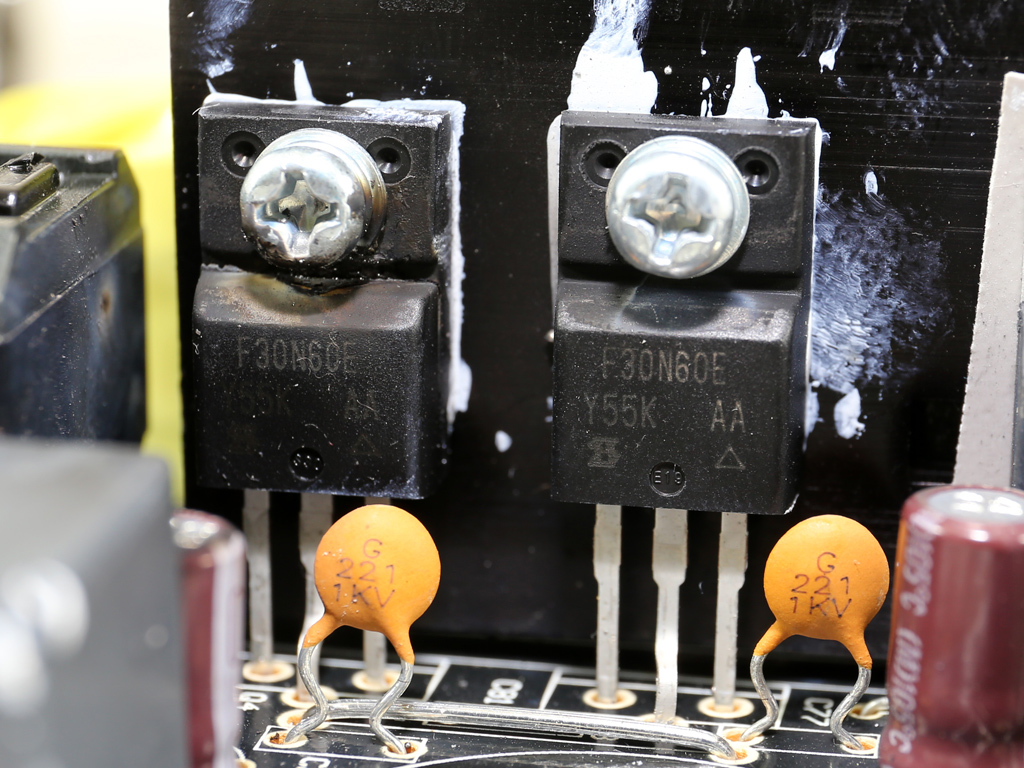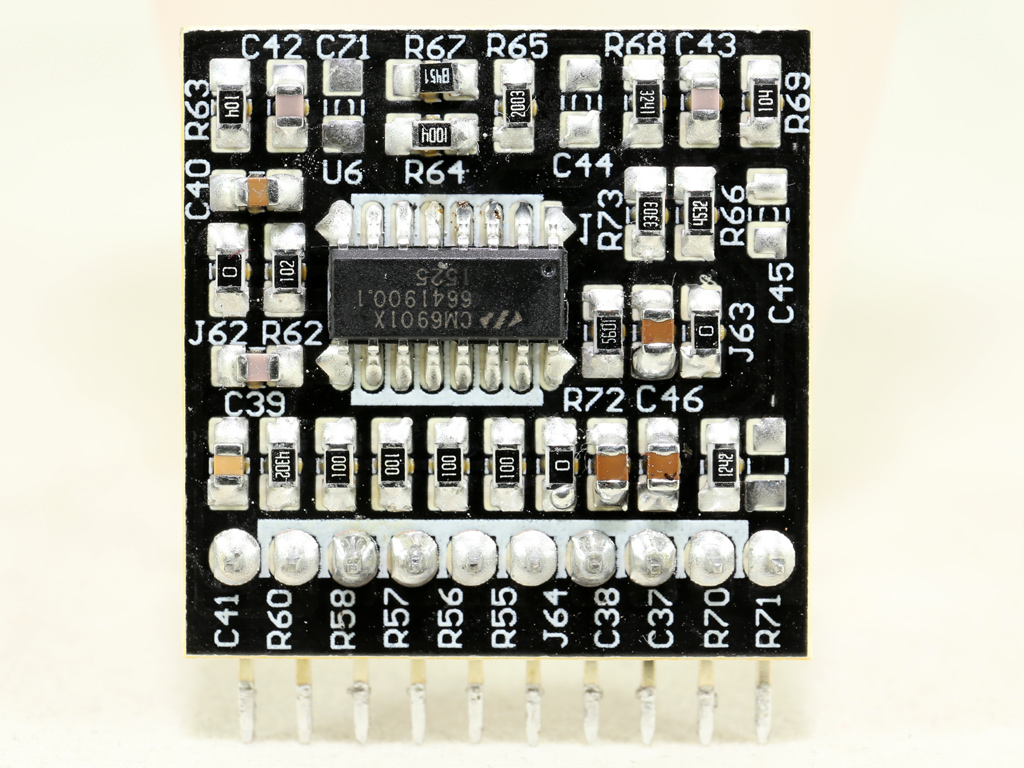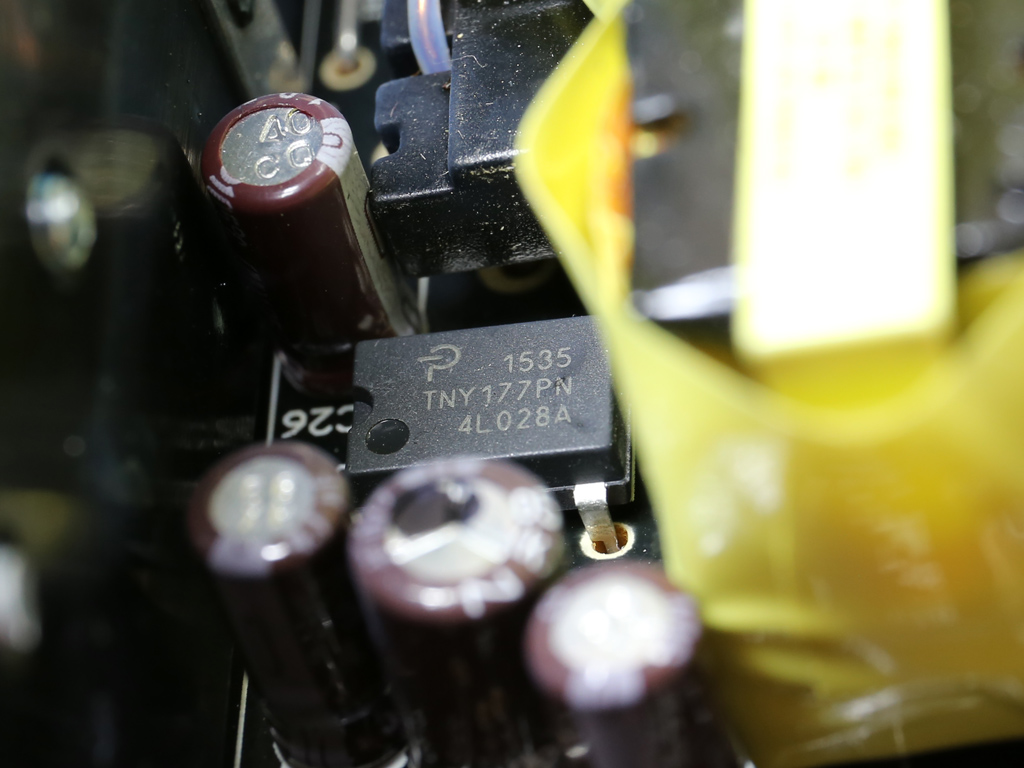Enermax Revolution X’t II 750W Power Supply Review
Enermax recently released a successor to the Revolution X't line and the new models are made by CWT, featuring 80 PLUS Gold efficiency, Japanese caps and a quality fan. Today, we're testing the ERX750AWT model.
Why you can trust Tom's Hardware
A Look Inside And Component Analysis
Parts Description
Before proceeding with this page, we strongly encourage you to a look at our PSUs 101 article, which provides valuable information about PSUs and their operation, allowing you to better understand the components we're about to discuss. Our main tools for disassembling PSUs are a Thermaltronics soldering and rework station, and a Hakko 808 desoldering gun.
| Primary Side | |
|---|---|
| Transient Filter | 4x Y caps, 2x X caps, 2x CM chokes, 1x MOV, 1x CAP004DG |
| Inrush Protection | NTC Thermistor & Relay |
| Bridge Rectifier(s) | 1x GBU15L06 (600V, 15A @ 115 °C) |
| APFC MOSFETs | 2x GP28S50G |
| APFC Boost Diode | 1x CREE C3D100060A (600V, 10A @ 153 °C) |
| Hold-up Cap(s) | 1x Nippon Chemi-Con (400V, 560uF, 2000h @ 105 °C, KMR) |
| Main Switchers | 2x Vishay Siliconix SIHF30N60E (650V, 18A @ 100 °C, 0.125 ohm) |
| APFC Controller | Champion CM6502S & CM03X Green PFC controller |
| Switching Controller | Champion CM6901 |
| Topology | Primary side: Half-Bridge & LLC Resonant Converter Secondary side: Synchronous Rectification & DC-DC converters |
| Secondary Side | |
| +12V MOSFETs | 6x SG40N01D |
| 5V & 3.3V | DC-DC Converters: 2x UBIQ QM3006D (30V, 57A @ 100 °C, 5.5 mohm) 2x UBIQ QM3016D (30V, 68A @ 100 °C, 4 mohm) PWM Controller: APW7159 |
| Filtering Capacitors | Electrolytics: Nippon Chemi-Con (105 °C, KY, KZE) Polymers: Nippon Chemi-Con (Japan), Enesol (Korea) |
| Supervisor IC | Sitronix ST9S313-DAG (OVP, UVP, SCP) |
| Fan Model | Enermax ED142512M-OA (139mm, 12V, 0.45A, Twister Bearing) |
| 5VSB Circuit | |
| Standby PWM Controller | TinySwitch-LT TNY177PN (18W Peak) |
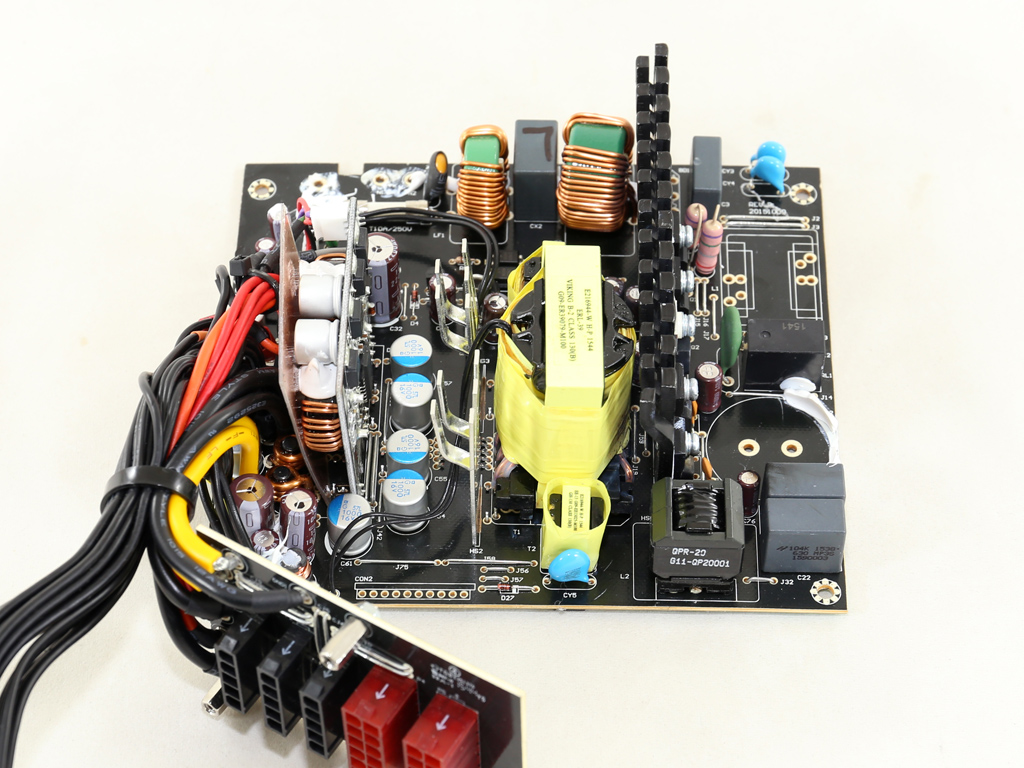
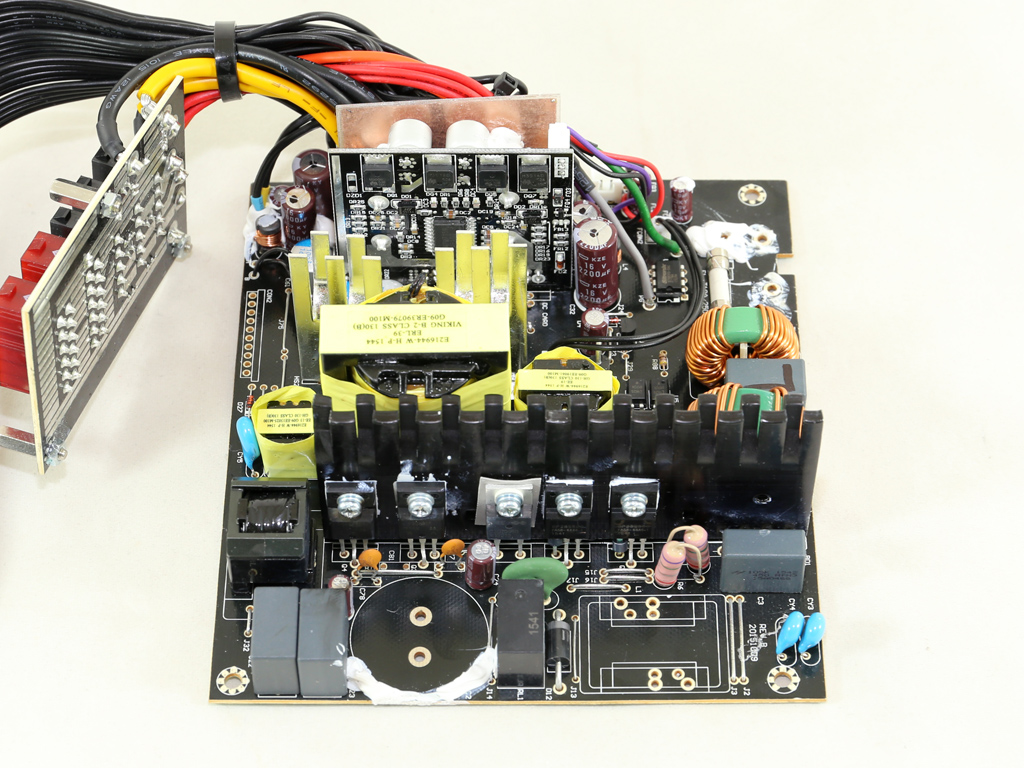
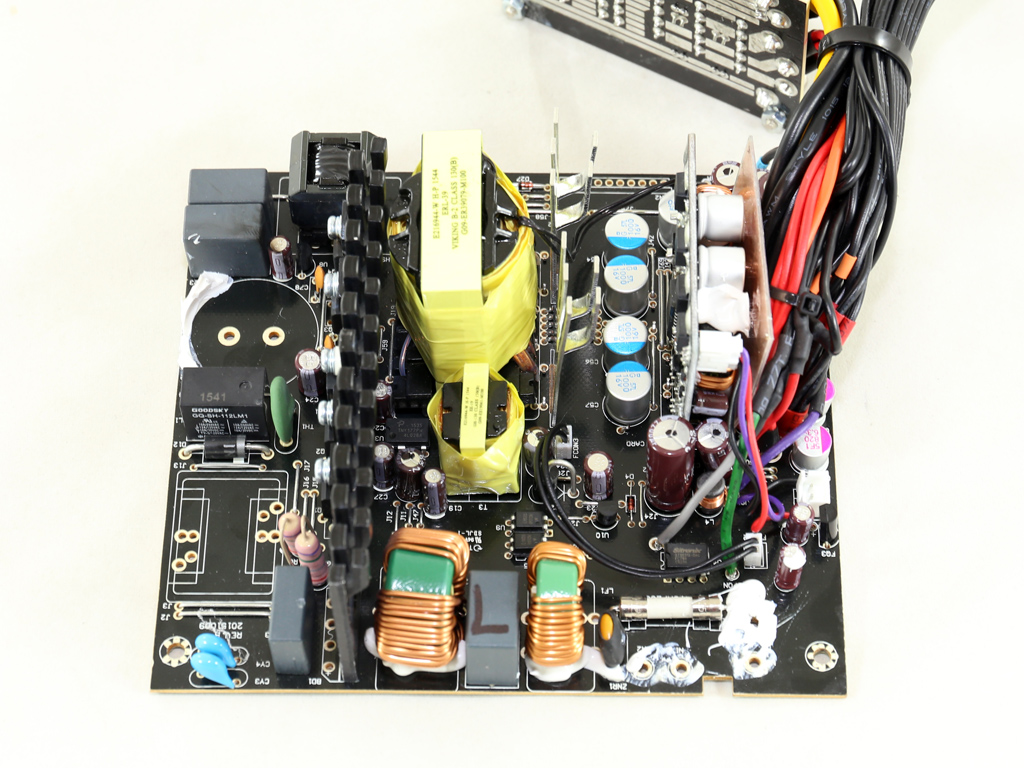
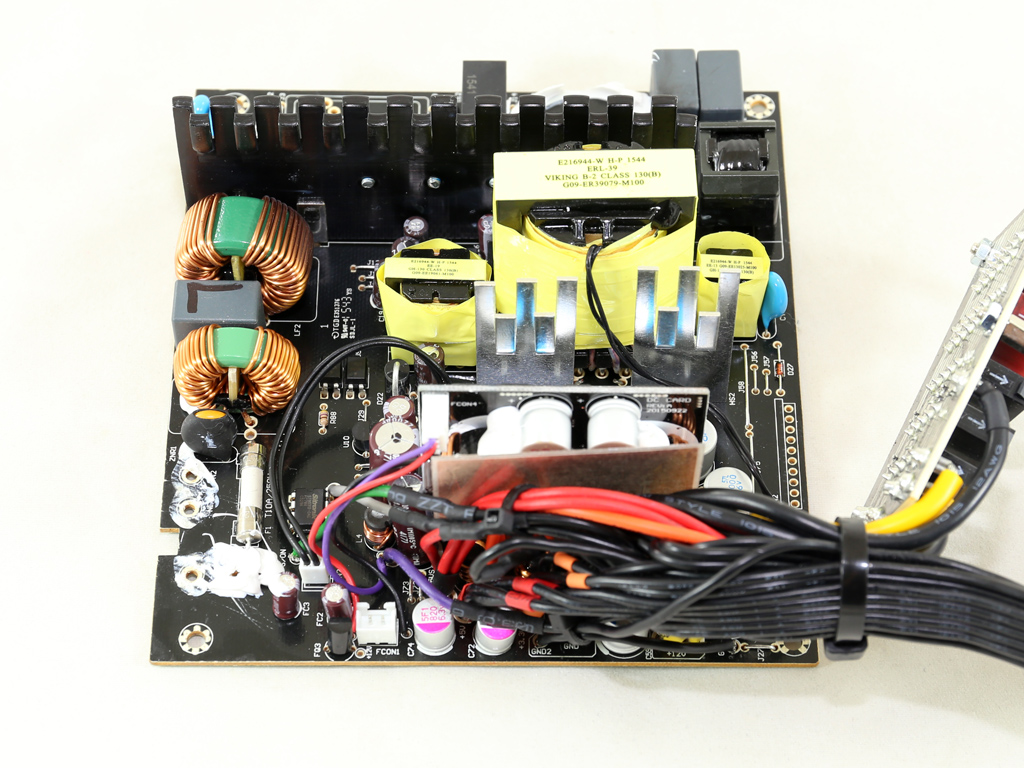
Since Enermax doesn't have a manufacturing line anymore, the company collaborated with CWT for the Revolution family. The ERX750AWT is based on that company's GPS platform, which utilizes an LLC resonant converter for increased efficiency. Enermax spared no expense on the capacitors, arming this PSU with high-quality Japanese electrolytic caps and a mix of Japanese and Korean polymer caps.
On the primary side, the heat sink is quite large. Meanwhile, two small heat sinks are installed on the secondary side, helping to dissipate heat from the +12V FETs. The design is modern but not exactly cutting-edge, so it doesn't compete directly with high-end units like Corsair's RM750x and EVGA's SuperNova 750 G2. We should note that CWT's GPS platform is also used by Thermaltake in the Smart DPS G 650W/750W units with digital interfaces. This is a decent performer, and the use of quality caps is a major advantage. But it's not perfect (more on that shortly).

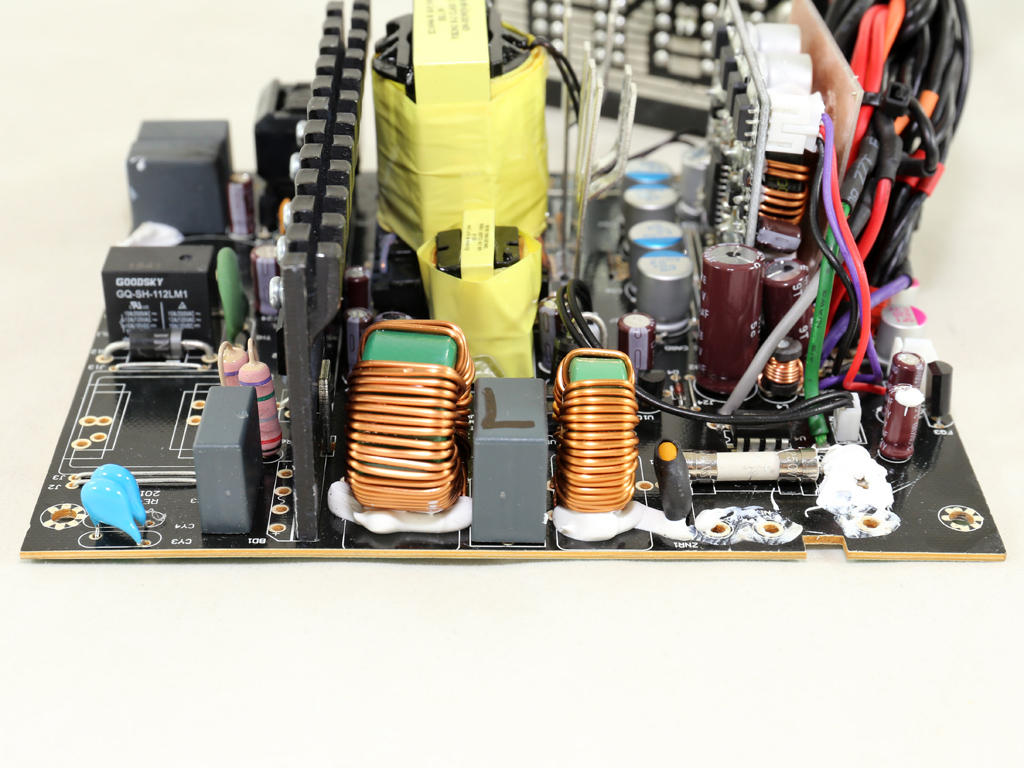
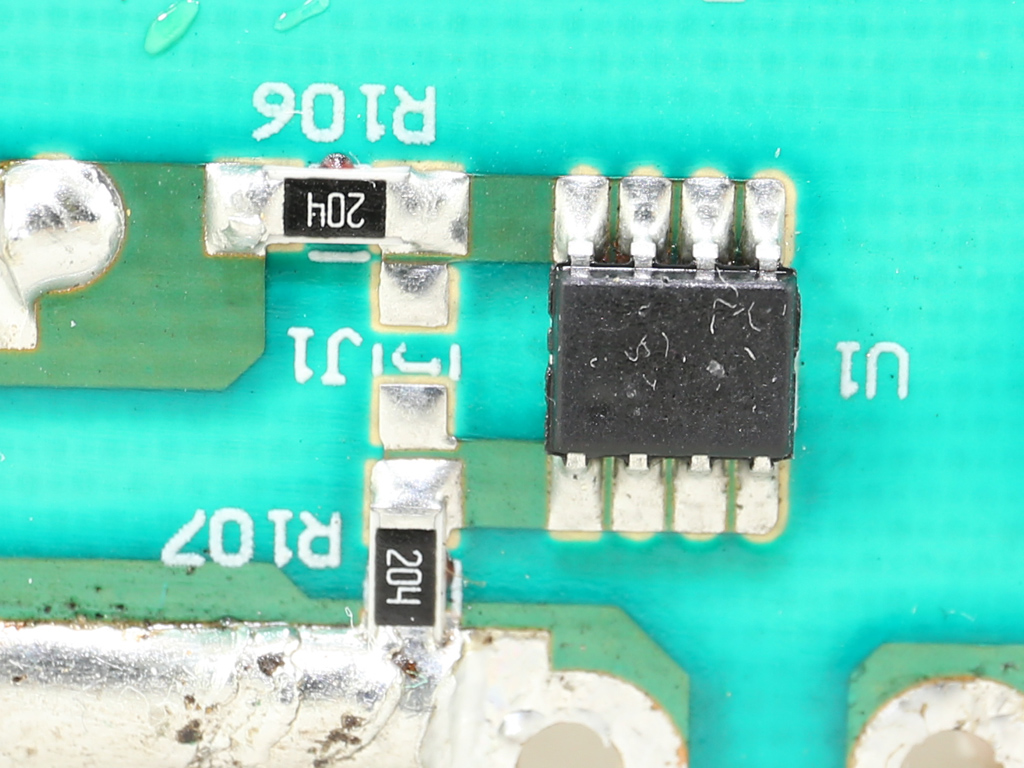
The EMI filter starts in the AC receptacle with two Y caps and a single X cap. It continues on the main PCB with two CM chokes, one X and two Y caps, with the latter installed after the bridge rectifier. There is also an MOV that provides protection against spikes and surges coming from the mains network. The transient/EMI filter is complete.
On the PCB's solder side, we spot a Power Integrations CAP004DG discharge IC that blocks current through X cap discharge resistors when AC voltage is connected, and automatically discharges X caps through the corresponding bleeding resistors when AC is disconnected. This IC provides a small efficiency boost.
The single bridge rectifier is bolted on the large primary heat sink. Its model number is GBU15L06 and it can handle enough current to meet the demands of a 750W PSU.
An NTC thermistor protects against large inrush currents, which occur during the PSU's switch-on phase while the APFC's bulk cap charges. A bypass relay is installed right next to it. This relay helps keep the thermistor cool, where its resistance is high enough to prevent large inrush currents.
Get Tom's Hardware's best news and in-depth reviews, straight to your inbox.
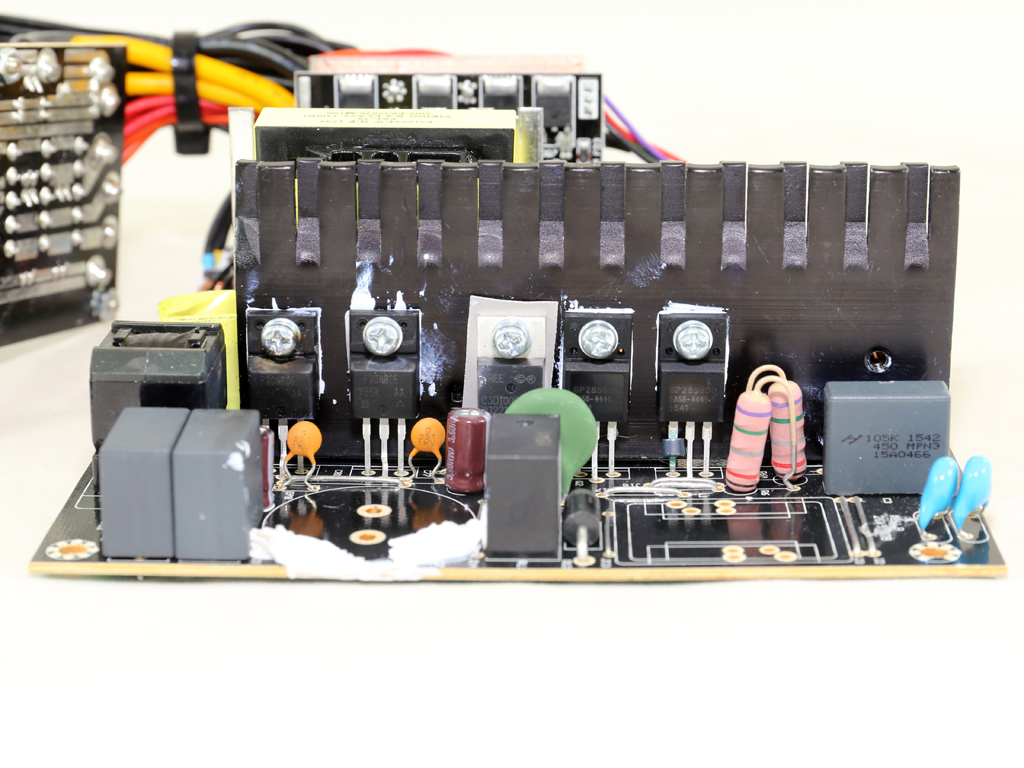
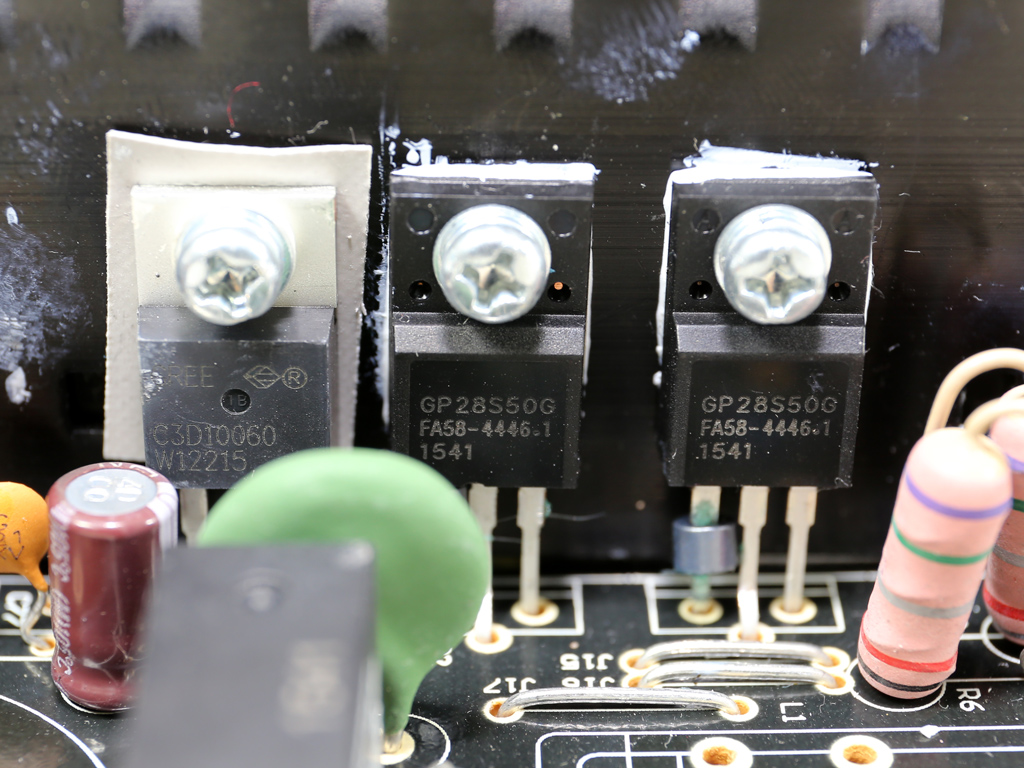


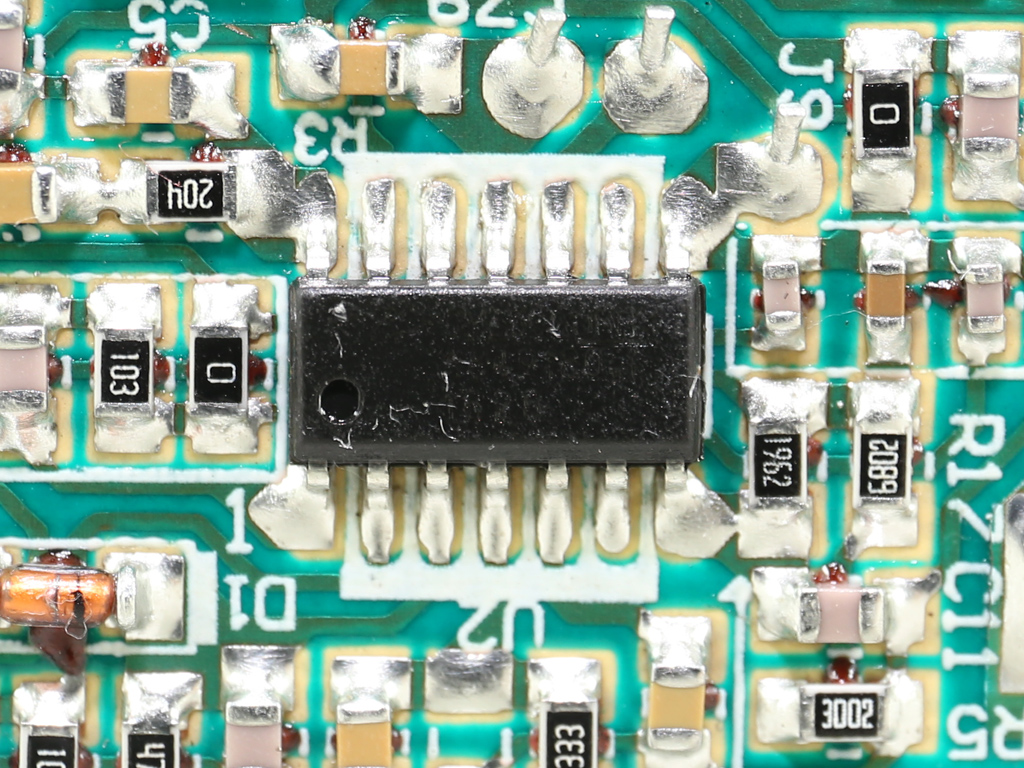
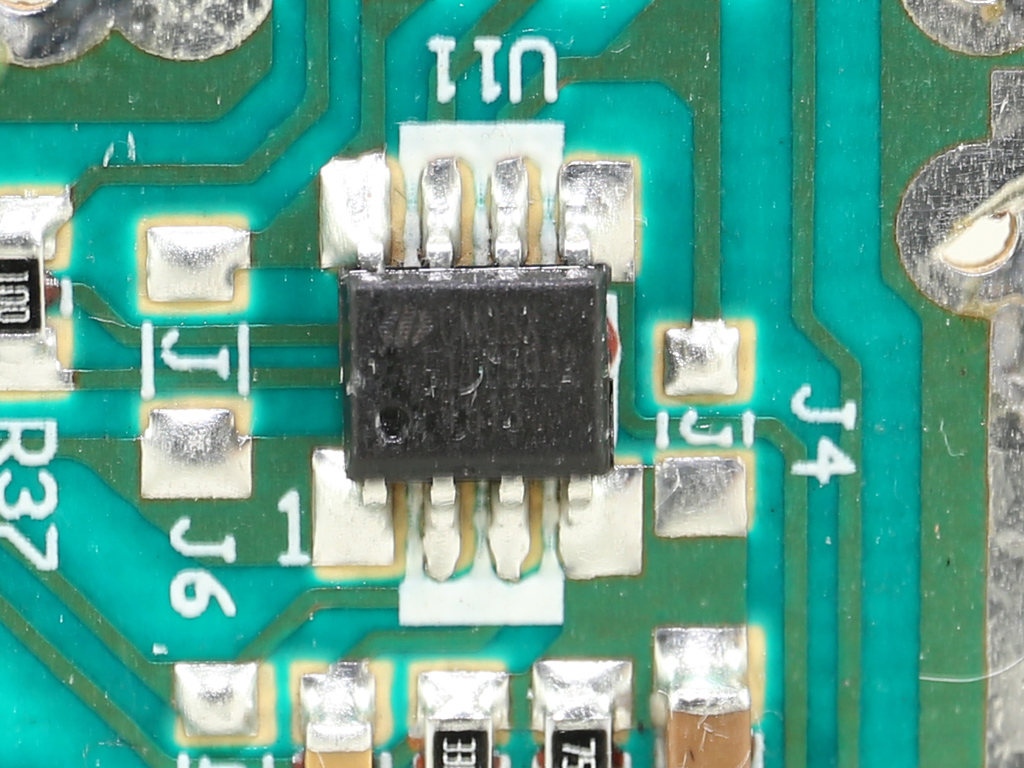
In the APFC converter, we find two GP28S50G FETs and a single CREE C3D100060A boost diode. We tried but failed to figure out who manufactures these FETs; if you know anything about this, please leave a comment. The APFC controller is installed on the solder side of the PCB and it is the famous Champion CM6502S, which is used in many Gold- and Platinum-rated PSUs, and even in some Titanium-rated units like the Raidmax Monster RX-700AT. The APFC controller is supported by a CM03X Green PFC controller that restricts power consumption below 0.5W at standby. Finally, the bulk cap comes from Chemi-Con (400V, 560uF each, 2000h @ 105 °C, KMR) and its capacity is low for a 750W PSU; we don't expect to measure a long enough hold-up time.
The main switching FETs are a couple of Vishay Siliconix SIHF30N60Es. They're high-quality FETs strong enough for this unit's needs. However, during our hold-up tests, where we switch the PSU on and off repeatedly while it delivers full power, something went wrong and one of the FETs literally exploded. There was likely something wrong with the first sample Enermax sent us, so we asked for a second one. Still, the product has to lose performance points because of this issue. While it'll likely never face a full load during switch-on in the real world, we still expect review samples to handle this scenario. Rarely do we encounter failures in these tests.
The dark marks on the resonant tank's caps and the small Chemi-Con cap reveal the magnitude of the explosion.
The resonant controller is housed on a small daughterboard. It is a Champion CM6901.
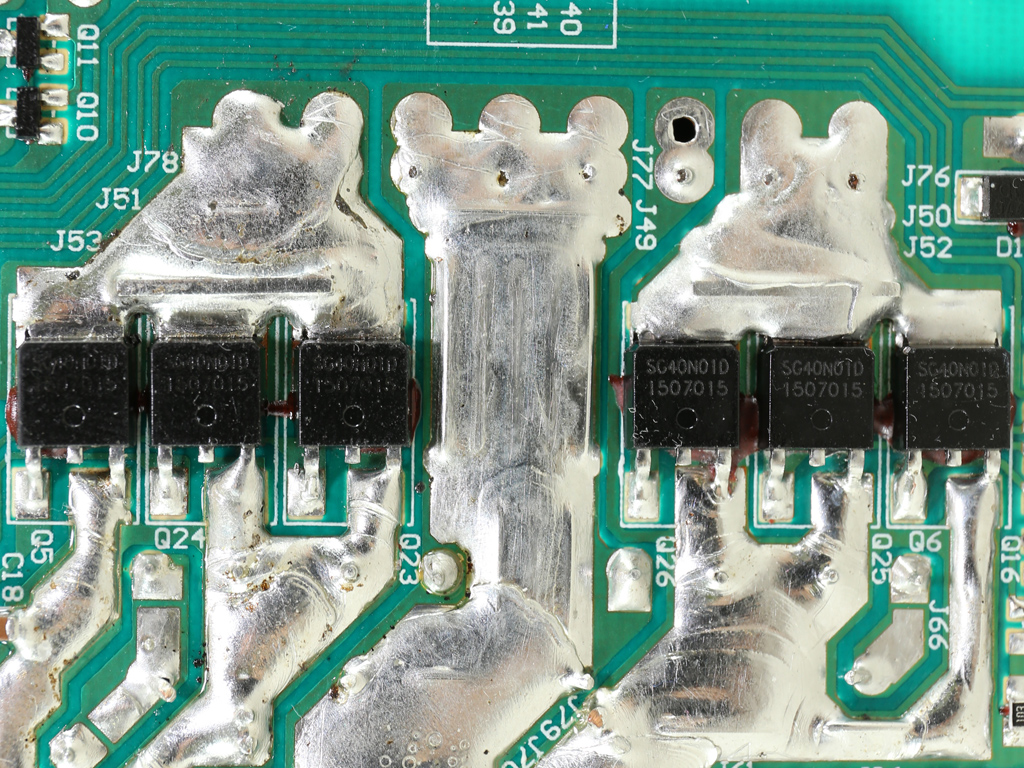

On the secondary side, the +12V rail is generated by six SG40N01D FETs installed on the PCB's solder side. Again, we were unable to find any details on these FETs.


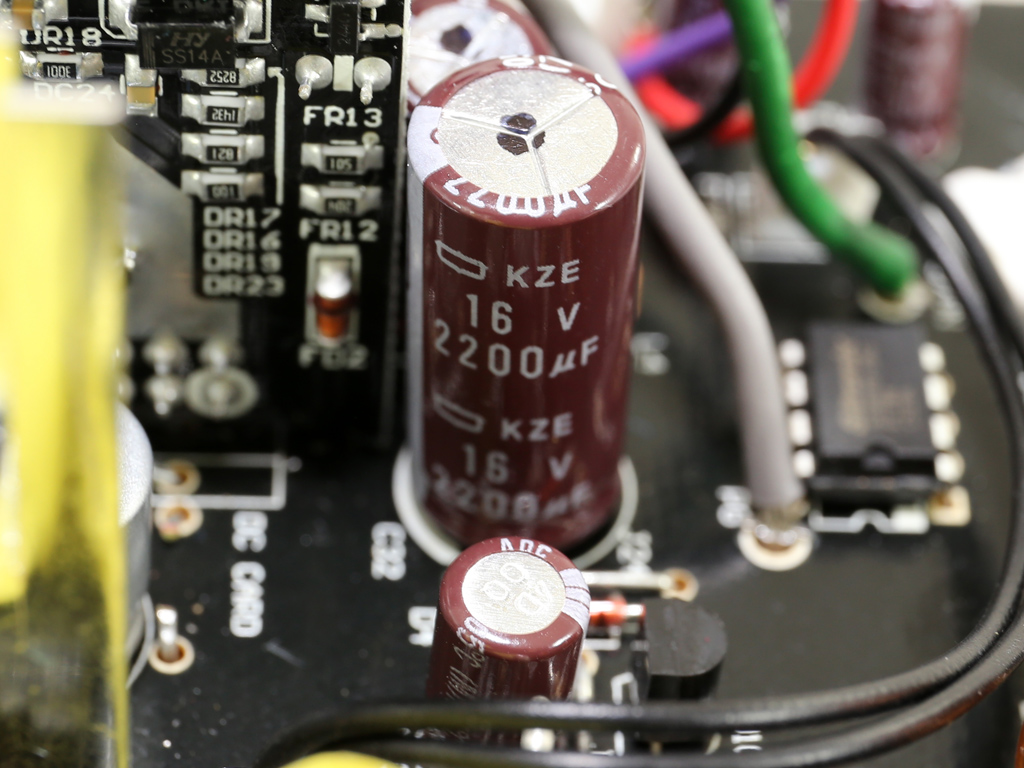
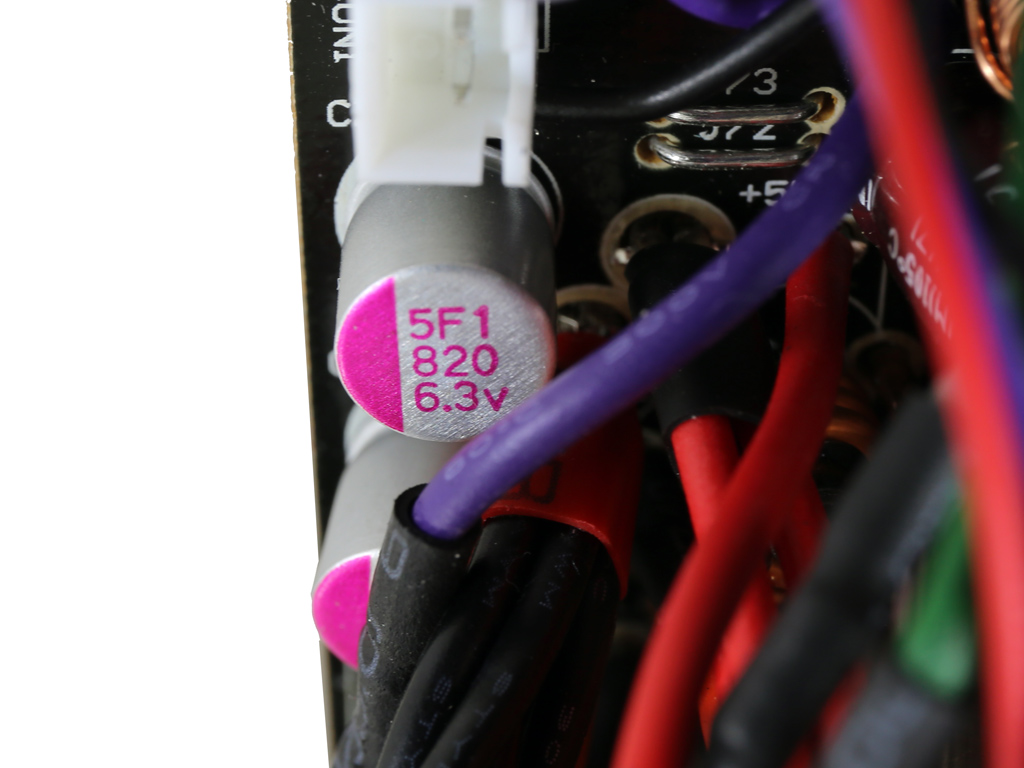

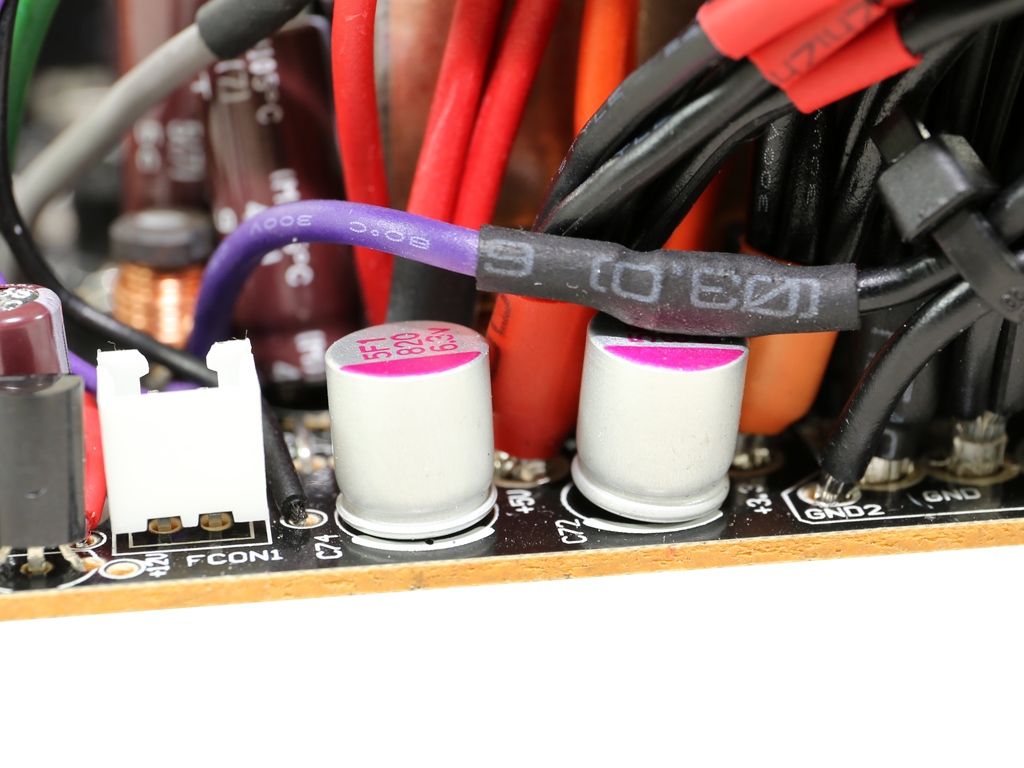

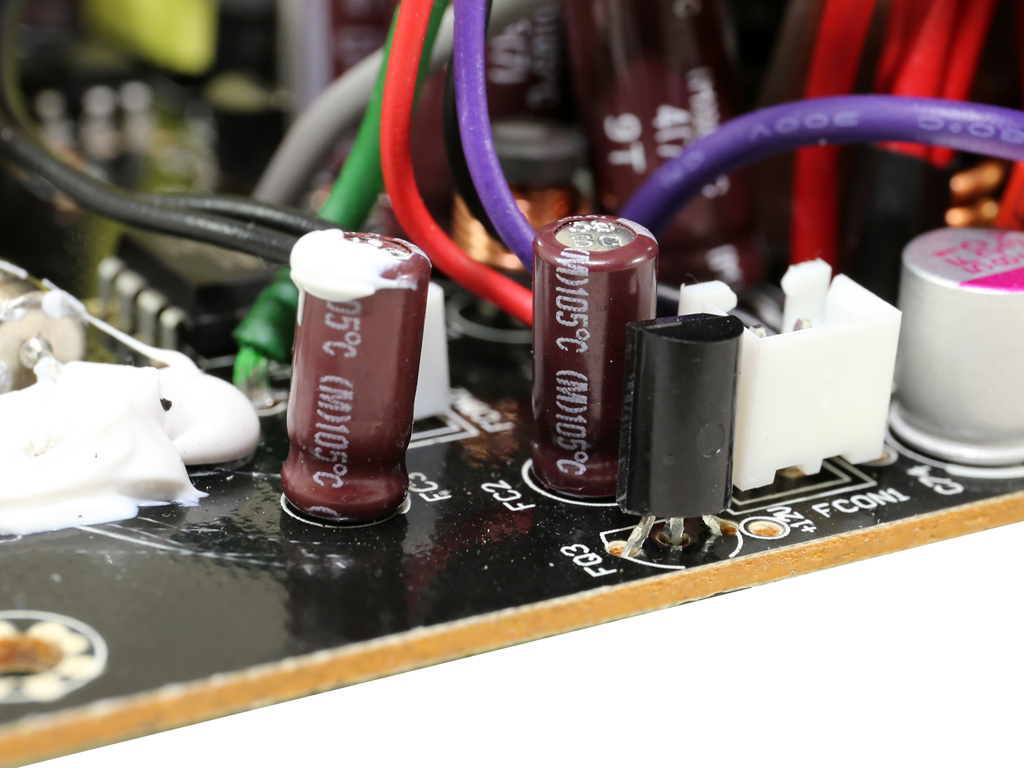

The electrolytic filtering caps are provided by Chemi-Con. The large ones belong to the KZE series, while the smaller ones are higher-quality KY models. Besides electrolytic caps, Enermax also deployed a mix of Chemi-Con and Enesol polymer caps for filtering purposes.
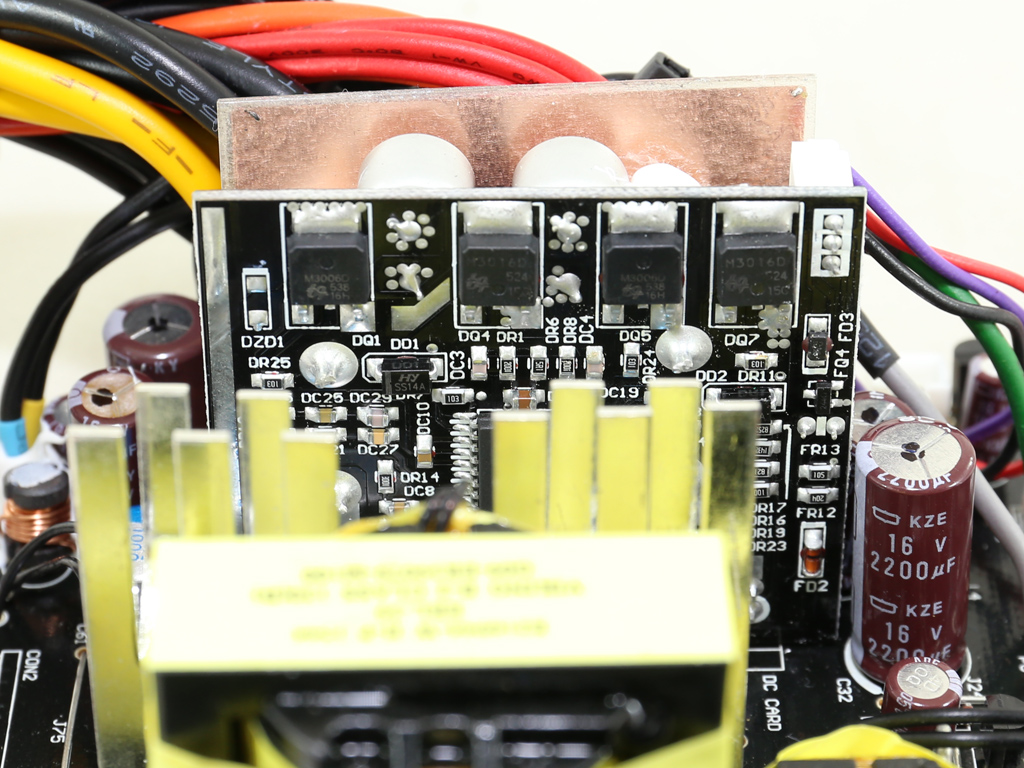

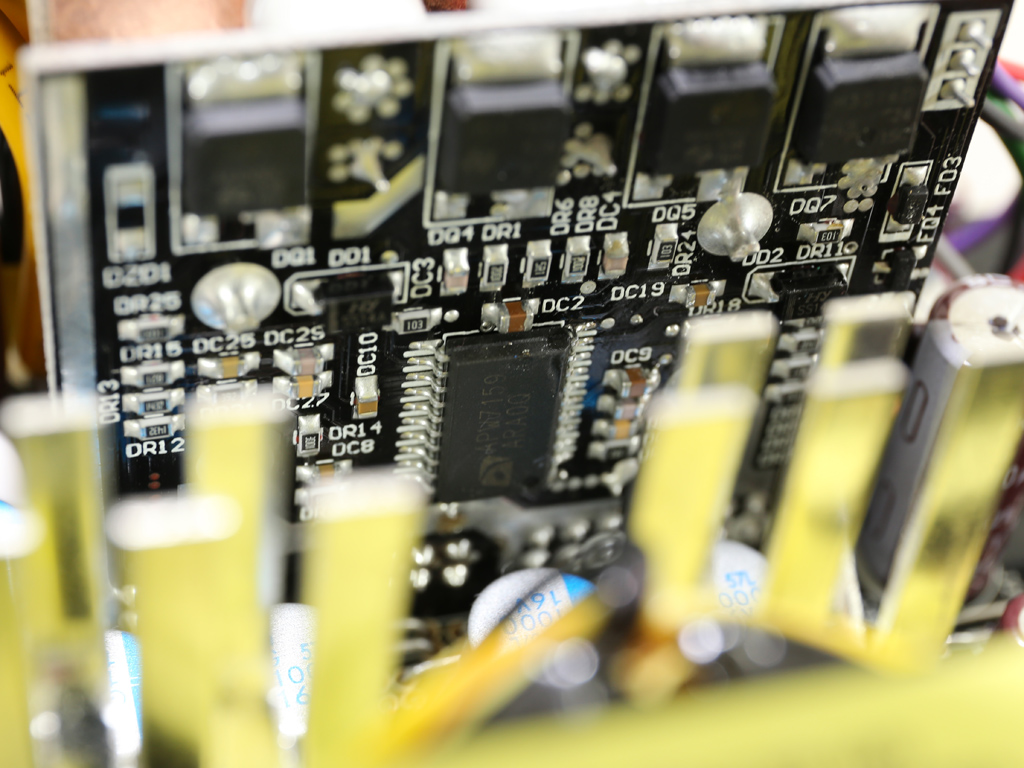
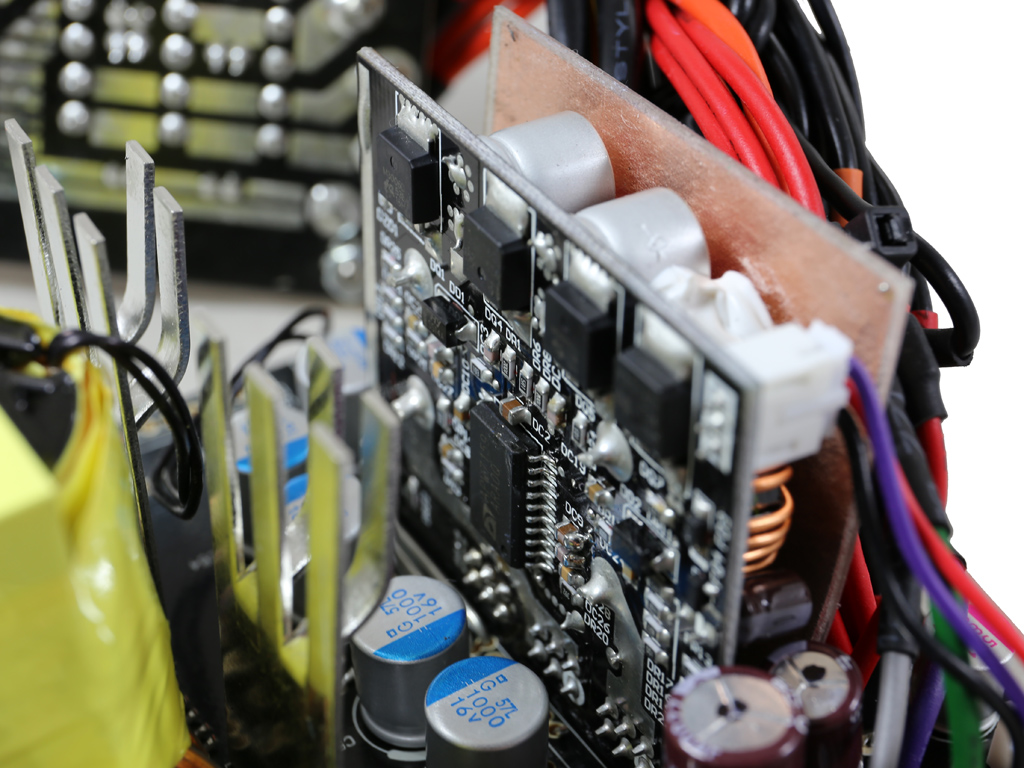
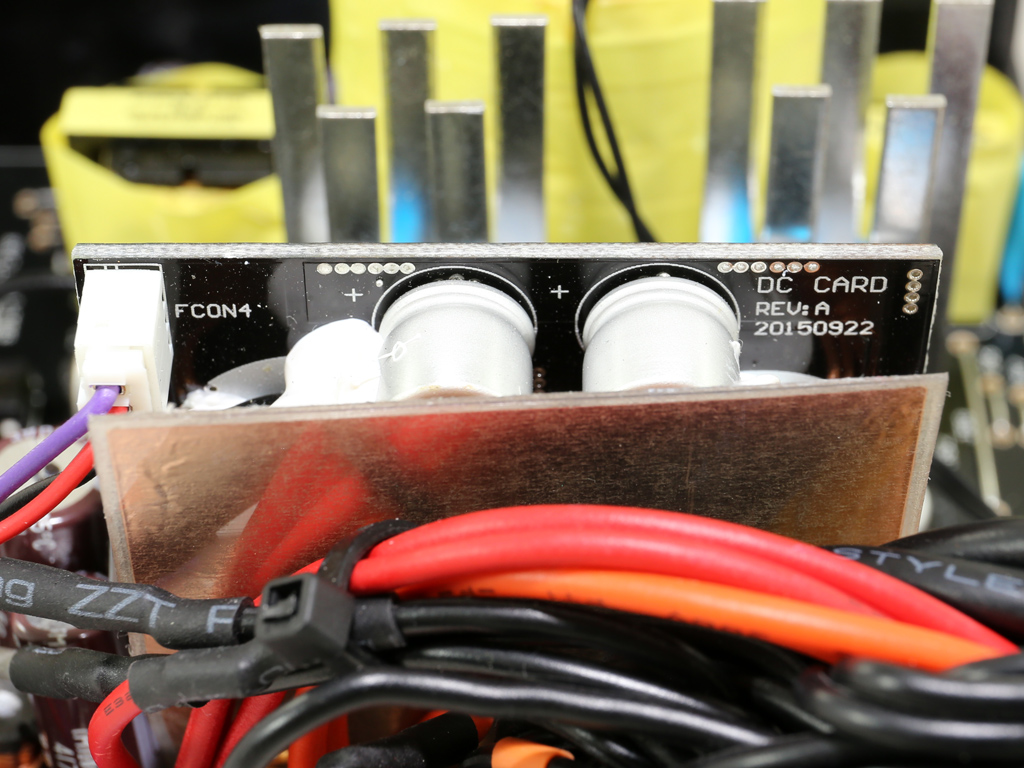
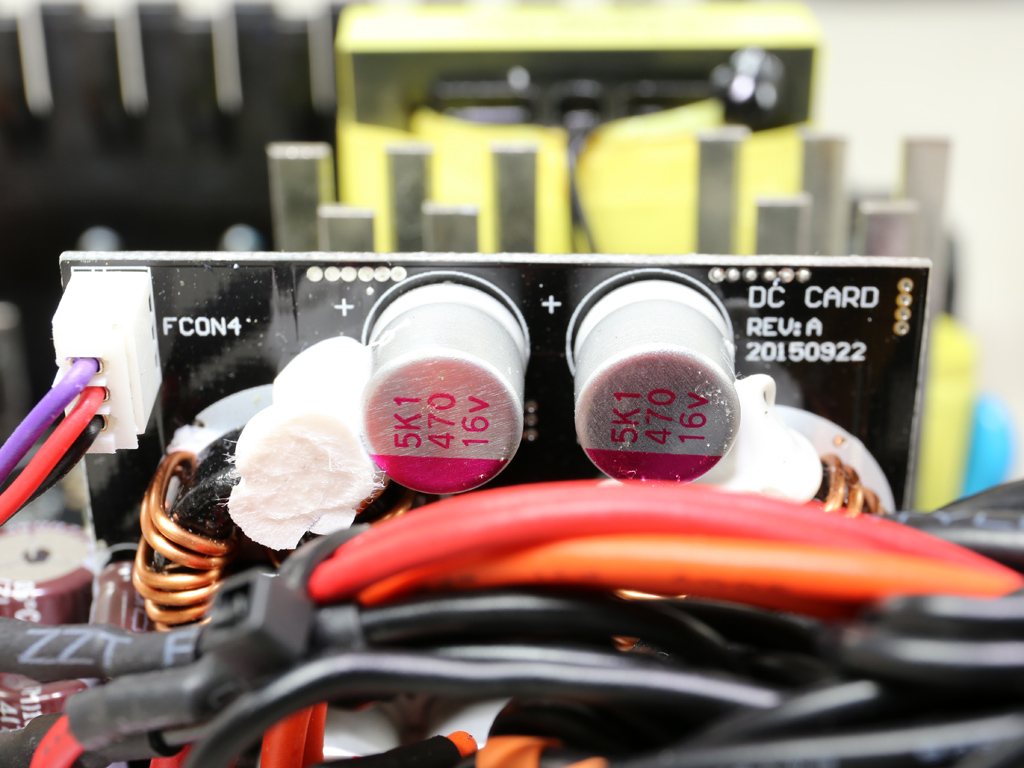
The DC-DC converters responsible for regulating the minor rails use UBIQ FETs, two QM3006D and two QM3016D. Four Enesol polymer caps help filter these rails, and the common PWM controller is an ANPEC APW7159.
The supervisor IC is a Sitronix ST9S313-DAG (OVP, UVP, SCP), which provides a limited set of protection features. In a higher-end PSU like this one, we want to see a more capable supervisor IC with over-temperature protection support.
The standby PWM controller is a TinySwitch-LT TNY177PN, capable of providing up to 18W of power with a wide voltage input range (given appropriate cooling).

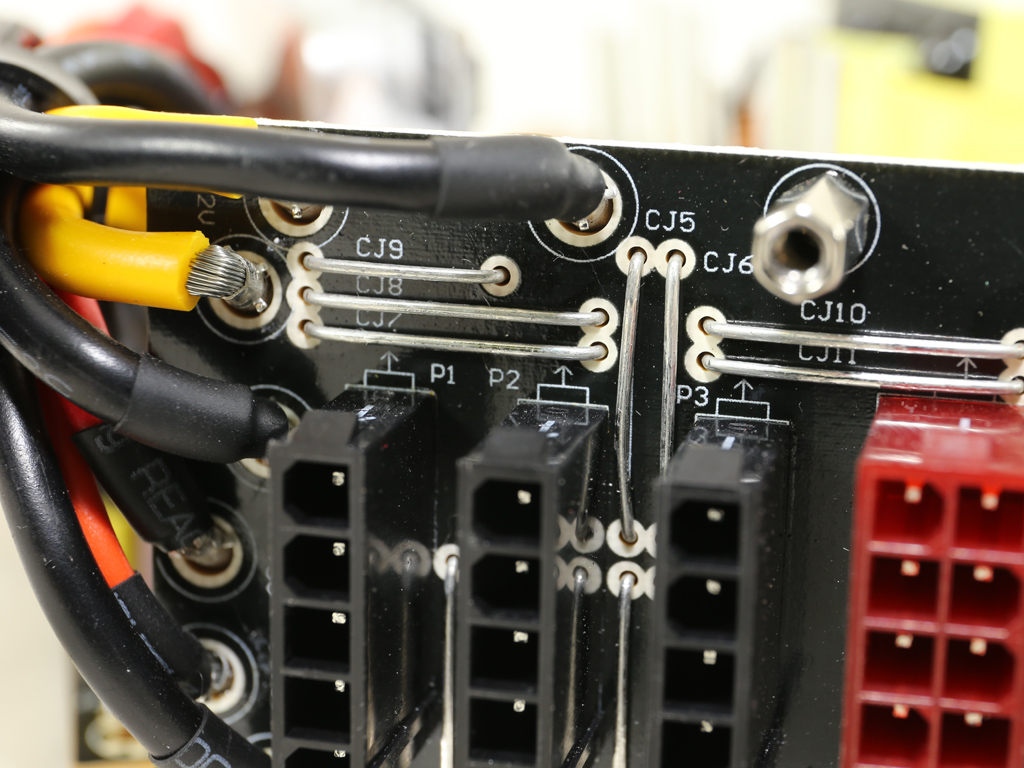
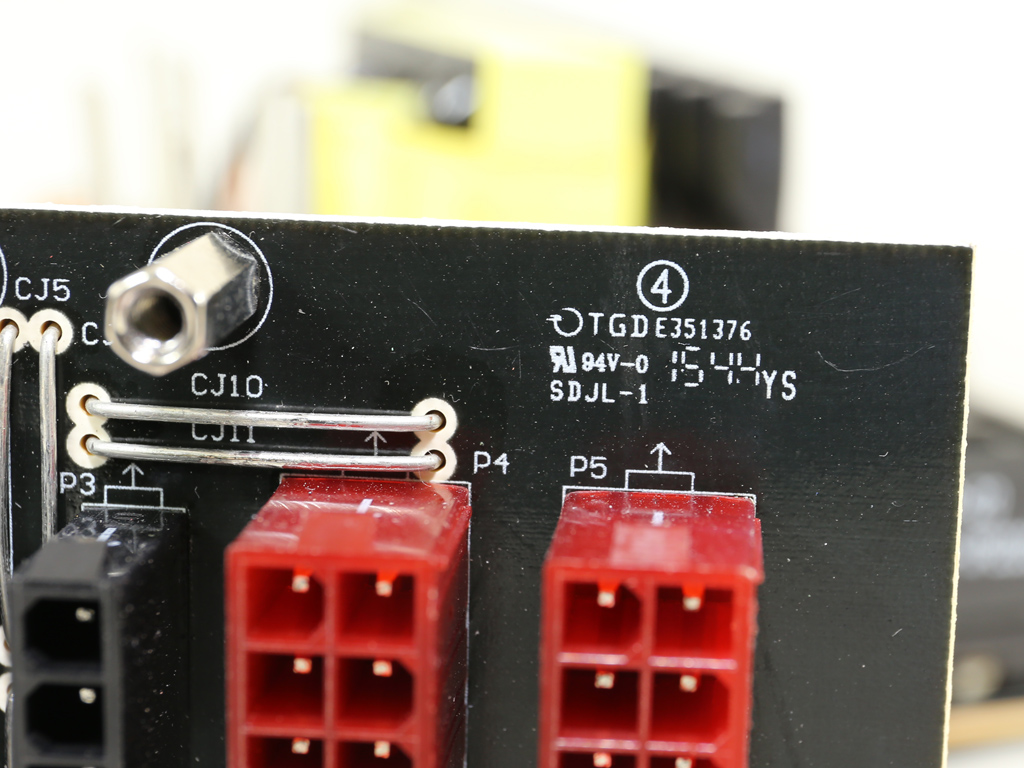

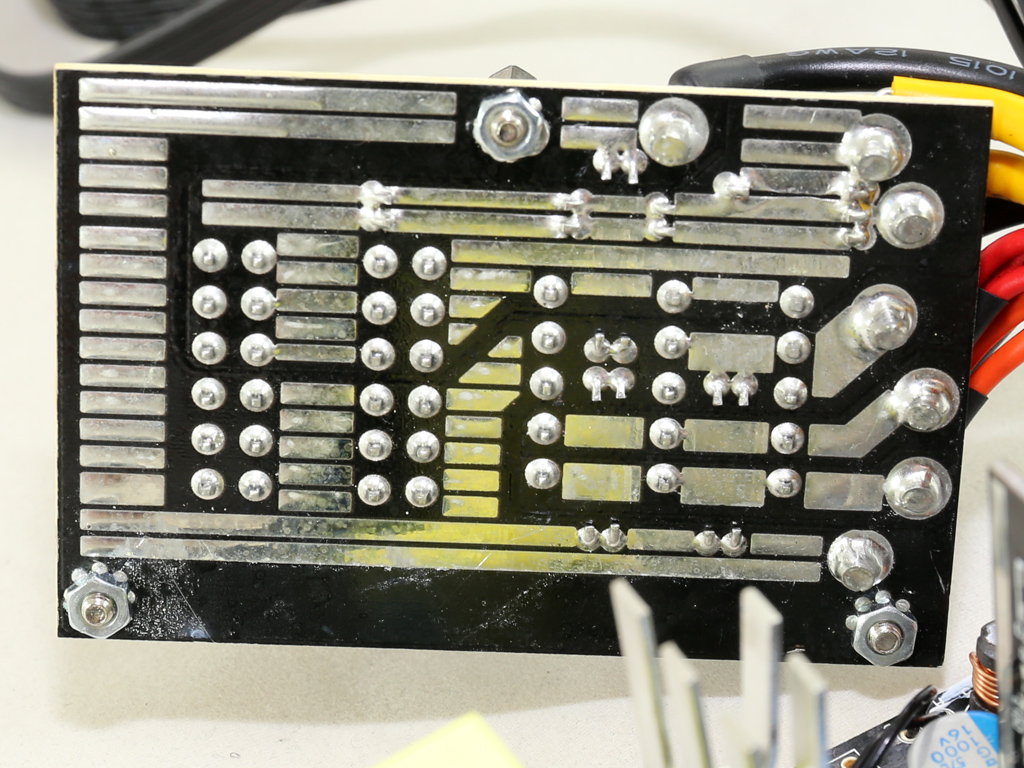
The modular PCB doesn't host any filtering caps for extra ripple filtering.
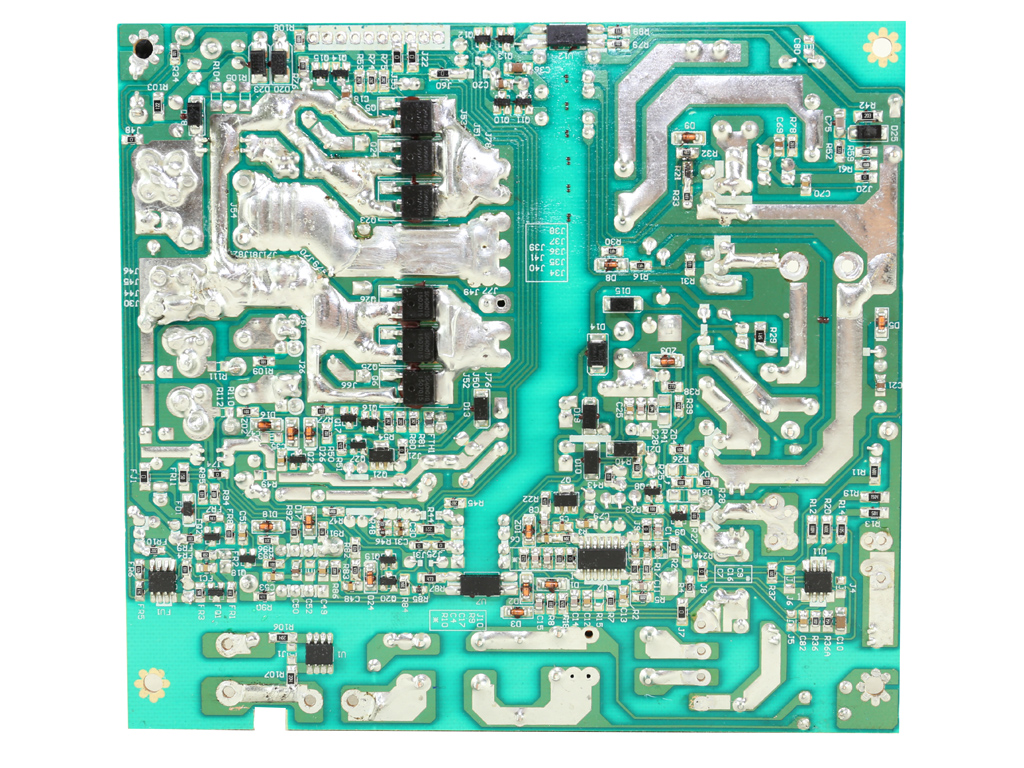

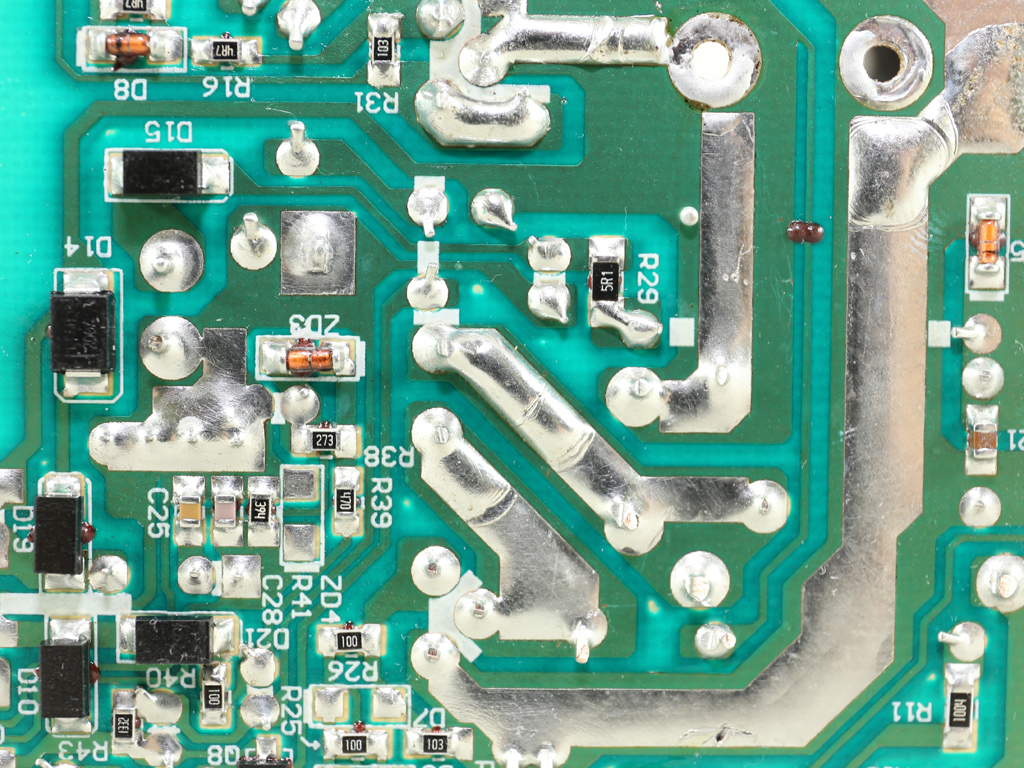
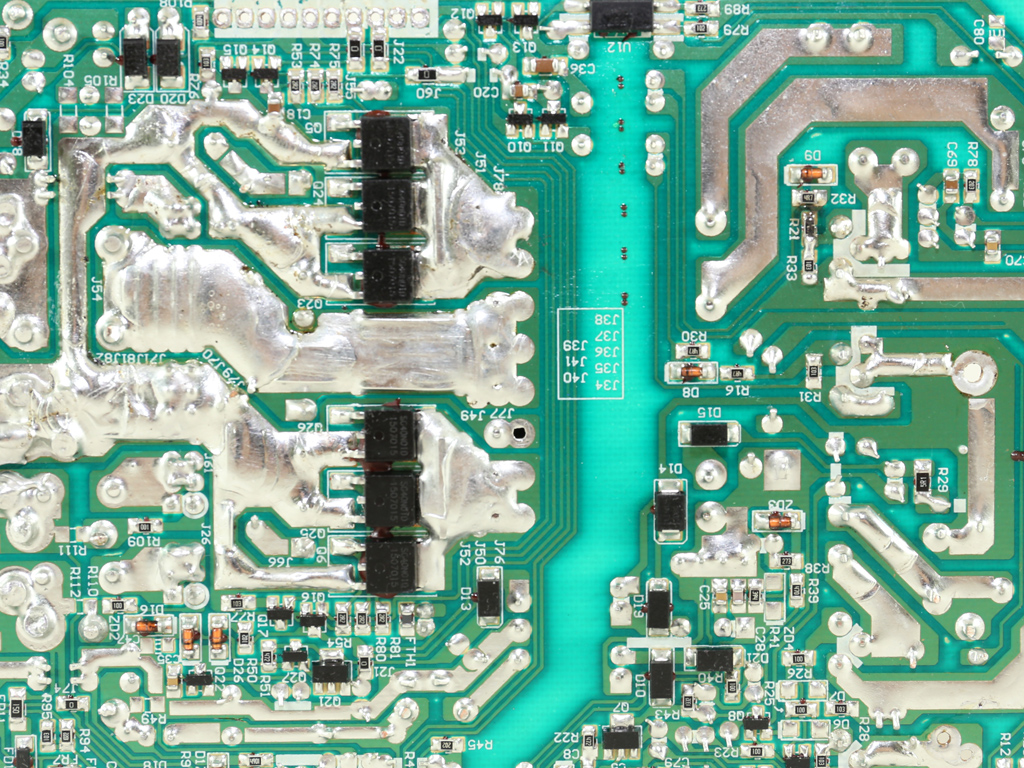
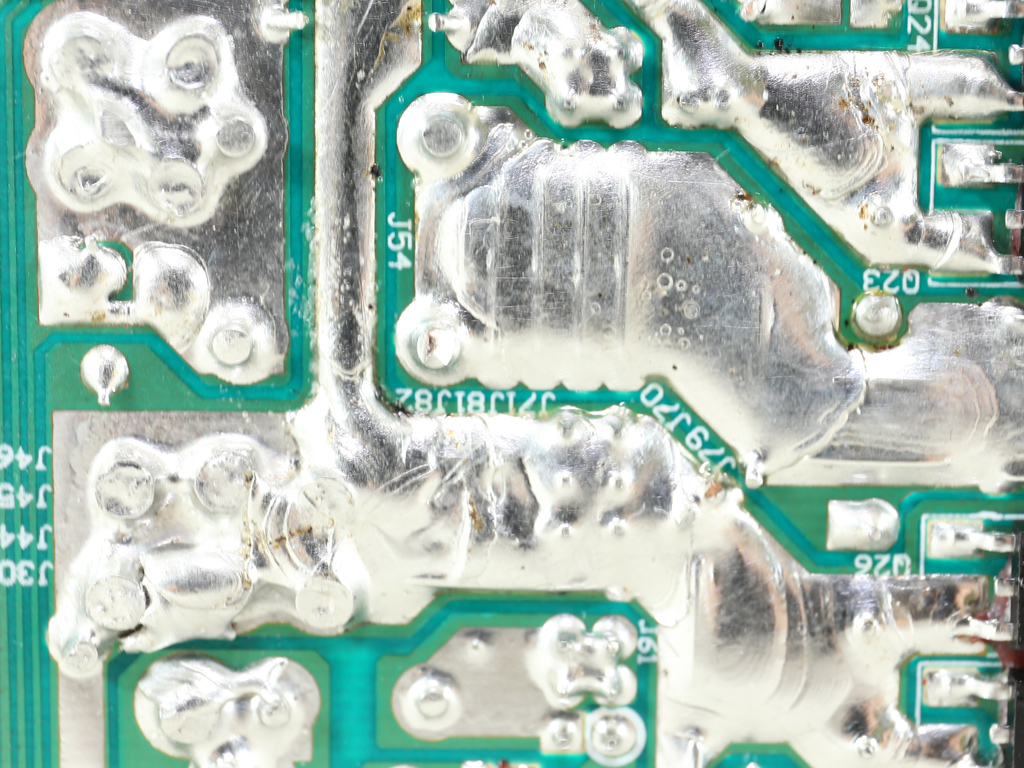
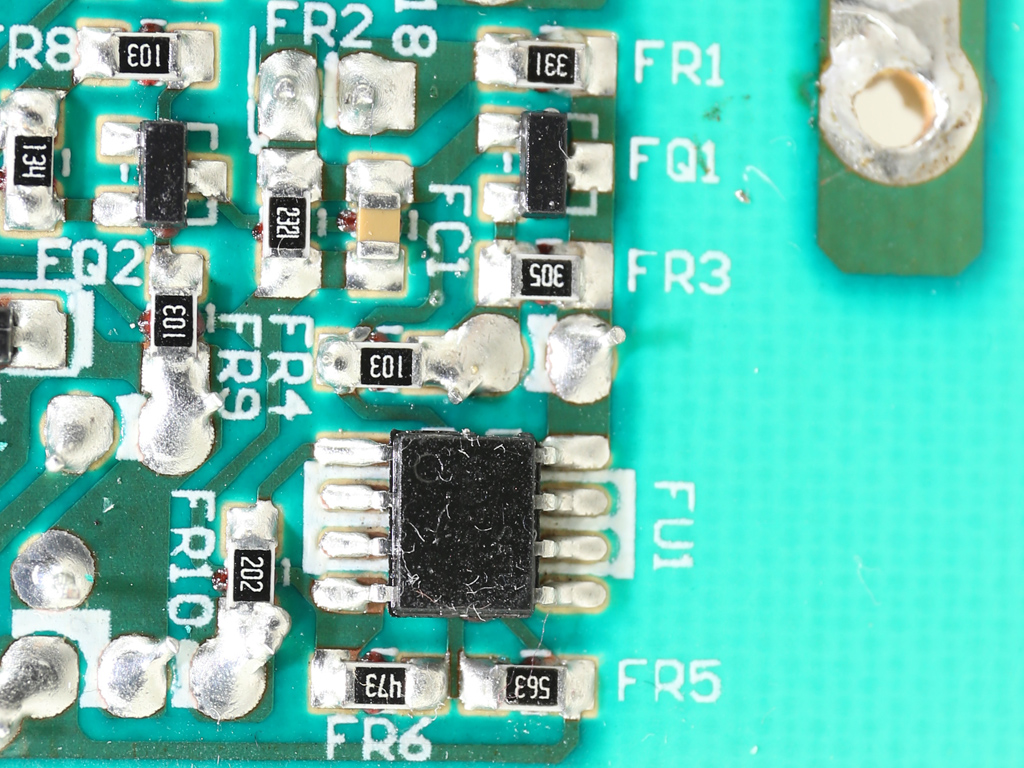

The soldering quality is mediocre, especially on the secondary side where the conductive paths are enhanced by extra layers of solder. Obviously CWT didn't use its best soldering equipment for manufacturing this PSU.

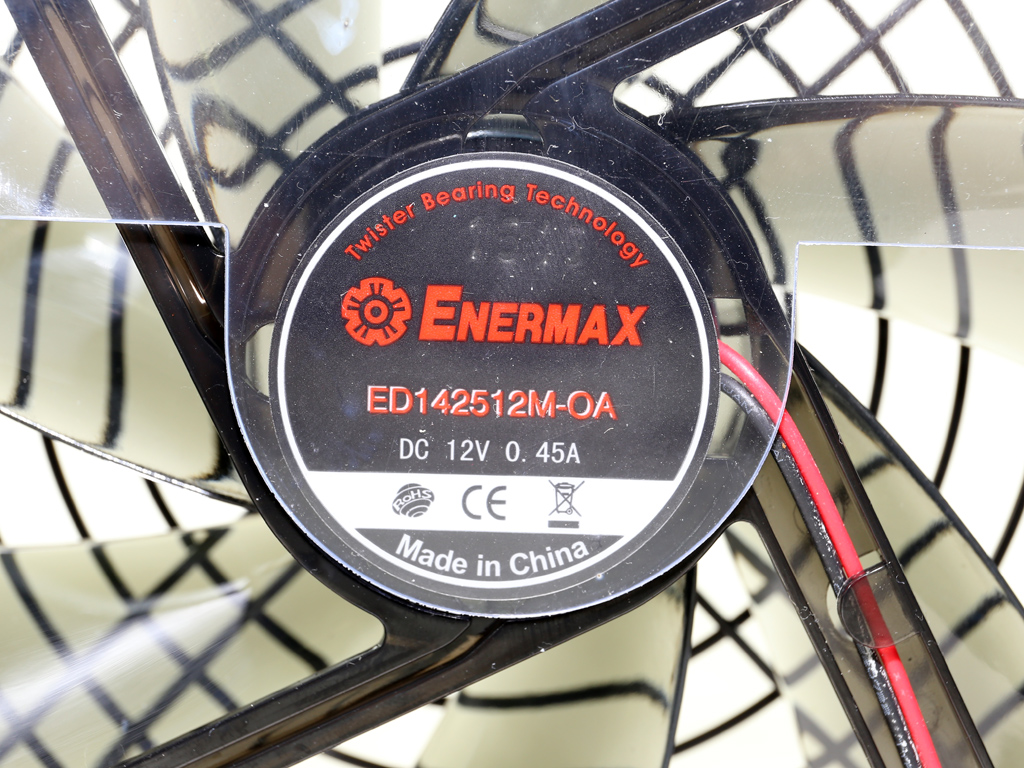
The cooling fan carries Enermax's logo and uses a twister bearing, which offers a long lifetime to match the high-quality FDB and HDB fans we're more familiar with. Enermax cites a 160,000-hour MTBF for this fan. Its profile is fairly relaxed, so under normal conditions the ERX750AWT is quiet.
Current page: A Look Inside And Component Analysis
Prev Page Packaging, Contents, Exterior And Cabling Next Page Load Regulation, Hold-Up Time And Inrush Current
Aris Mpitziopoulos is a contributing editor at Tom's Hardware, covering PSUs.
-
powernod The fact that the PSU collapsed during the "Hold-UP time / Power_OK" tests, clearly proves -in my opinion-, how important these tests are, since they are an indication of how properly a PSU can react during stressful situations. ;)Reply -
turkey3_scratch Good unit. Has some things that could be improved, but good. Wish there was much more to say.Reply -
Aris_Mp actually I rarely see a PSU going boom in these tests. Will wait for the second sample to arrive and see how it goes under the same scenario.Reply -
turkey3_scratch Reply17939497 said:actually I rarely see a PSU going boom in these tests. Will wait for the second sample to arrive and see how it goes under the same scenario.
Oh I thought you already got the second sample and it tested fine, guess I misread that. -
GearUp The older line X't have been selling for around $82 so I would have hoped for a lower price as well. Personal experience still favors Enermax since 0/6 of my units failed within 3 months while it was 1/3 for each of 2 different competitors. I still factor in return costs at this point.Reply -
Aris_Mp Just finished testing the second sample and no fireworks this time, so apparently the incident with the first sample (during the hold-up time tests) was just an isolated one.Reply
In addition I confirmed that there is no OCP on the minor rails either, as I suspected. -
android_dev The older Enermax Revolution 87+ series have better build quality ,features and performance than their X't counterparts. Then again it was a more expensive platform to begin with.Reply -
GearUp Correction on returns: Only one supply was returned within 3 months which is good for returns. The other failed due to the motherboard or graphics card after 16 months. Some supplies have return rates well over 20 percent.Reply


